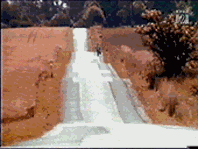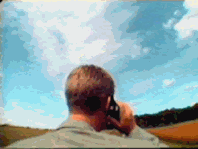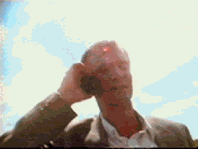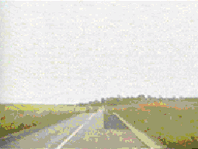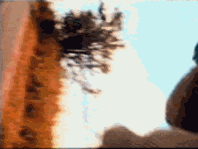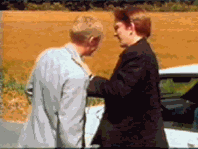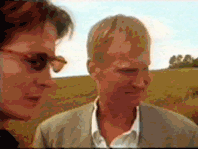|
Not long ago I had the opportunity of addressing an audience of French students on the subject of Danish cinema. Knowing that the Dogma 95 films were well known to French audiences, I screened The Celebration by Thomas Vinterberg. After the screening I asked the students whether the characteristic cinematography and editing of the film had blocked their understanding of its subject matter. "No," the answer resounded, "we're used to watching MTV." I was surprised by the answer, and I still believe that The Celebration is not an MTV movie, if such a thing exists. Although contradicted by the mere popularity of the film it might – from the point of view of the aesthetics of classical Hollywood – be said that The Celebration resists audience comprehension violating as it does one classical rule after the other, thus resembling the MTV style. Its stylistic format is, however, not that of the glossy MTV videos, but rather that of docu soaps, other formats of reality television, old-time documentary film and cinéma vérité. In relation to the subject matter of the film, the family celebration, the docu soap format authenticates the film although the professional cinematography (by Anthony Dod Mantle) and editing (by Valdis Oskarsdottír) is more elaborate than television production economy typically allows. Considering the fact that The Celebration is, however, not (only) made for TV, but for theatrical release, the notion of art cinema becomes relevant. What interests me in this short article is the relation between the art cinema/docu soap style on the one hand and the classical dramaturgy on the other. The dramaturgical angle is also relevant considering the fact that the dogma manifesto openly criticizes dramaturgy, stating that "Predictability (dramaturgy) has become the golden calf around which we dance", indicating that we should stop doing so. One might thus expect The Celebration not to follow the predictable rules of dramaturgy. Director Thomas Vinterberg, however, explained in an interview that he gave up that idea at a very early stage (Jensen 1998: 15).
By analyzing in further detail the dramaturgical structure of the film, I now wish to underline the thesis that the film dramaturgically speaking is highly conventional. The bottom line of dramaturgy is that stories consist – or for some dramaturgists should consist – of a number of phases. The number of phases vary as a result of the degree of detail wanted by the individual dramaturgist, but regardless of their actual number the phases are always in a fixed order. Danish writer Trine Breum presents the paradigm of dramaturgy in six phases in the following order:[1]
The prelude introduces the theme and the conflict of the story. The prelude of The Celebration is limited to the first five scenes. In the first scene we see Christian, the son, come marching down a hilly country road. His cell-phone beeps and from fragments of the conversation we gather that something shocking will take place during the evening, but that Christian believes he can handle it. He then meets his brother Michael and during the next three scenes their sister, Helene, is also introduced. The presentation explains the who, what, where and when of the film. In The Celebration it consists of the presentation of family and friends (and of the relations between these), and it takes place in connection with the arrival at the castle at which the action will takes place. Important parts of this phase are 1) the presentation of the father, Helge, and the mother, Else, and of their relations to their son, Christian, and 2) the subsequent increasingly intense, crosscut 12 minute sequence depicting the two brothers and the sister in their respective rooms. This sequence culminates in four very short scenes related to Helene’s discovery of the late sister's suicide letter. The contents of the letter are withheld from the audience until later, but from Helene’s exorcising repetition "They must not find it, they must not find it," we understand the importance of it. The very strong marking of the discovery of the letter simultaneously marks what Breum calls the first turning point, i.e., "the change interfering with and changing the so far harmonious situation (Breum: 62) which also marks the "transition from the presentation to the clarification" (ibid.) In the beginning of the clarification phase the celebration takes off with before dinner drinks and entree. After the entree the eldest son, Christian, is to deliver the first speech, which marks the point of no return. From here there is no way out. The family secret has been revealed and as the staff led by Christian’s childhood friend, the chef Kim, intervenes and steals the guests’ car keys, even the guests – literally speaking – have no way out. The escalation of the conflict depicts the attempts of the characters to outmaneuver each other. Helene, the sister, calls Christian "insane"; Helge, the father, uses all his patriarchal authority in trying to put Christian back in place; Else, the mother, tries to pass the whole thing off by referring to Christian’s vivid imagination; and Michael, the brother, reacts violently. The brothers enter into a number of clashes, which, however, lead to no clarification. Michael is so afraid of his father that he does exactly what he is told, so when the father asks him to keep a watchful eye on everything, he interprets this literally and twice throws Christian out. Assisted by two male guests he even ties Christian to a tree in a nearby wood. At first only the staff and Helene’s boy friend, Gbartokai, side with Christian. This phase ends with the second turning point in which Helene cannot repress her knowledge of the suicide letter any longer and thus reads it aloud. The father admits his incestuous crime stating that the children did not deserve better. Everybody is now convinced that Christian has been telling the truth all along, but still Michael's reaction has not been depicted. He, who so far has explicitly denied the idea of incest, becomes the active part in the climax phase. Totally disconcerted he beats up his father and is about to urinate over him when Christian intervenes and overhears the completely defeated father saying: "Kill me!" In the fade, the last approximately five minutes of the film, we are at breakfast. Michael becomes the character who expels the father, who even loses the support of his wife. She chooses to remain at the breakfast table while he leaves the room totally defeated. Analyzing the temporal and causal relations within the film one also finds a classical, dramaturgical structure. At almost any given point we know exactly where the action takes place and we understand the causal relations between the elements. There are for instance many examples of common set up/pay off mechanisms, i.e., of elements or character traits which are presented (set up) in order to be used later (pay off). An example has to do with Helene hiding the suicide letter in a painkiller tube. This action is a set up for the pay off later when Pia finds that same letter after having been asked – by Helene – to go get her painkillers. One could go further into the dramaturgical aspects of the film, but the point should be clear by now: in terms of dramaturgy The Celebration is indeed very classic. There are, however, certain 'flaws' in this classic structure. Some of them break with classic rules of coherence, others join forces in providing the film with a metaphysical, mystical dimension. 1. Set up without pay off: who is Christian talking to on the cell phone in the opening shot? It is definitely a co-conspirator but the film never reveals his or her identity. The mystery is left unsolved, and the telephone conversation does not point forward toward a pay off but only serves to inform us that Christian's revelation is well planned.[2] 2. Mystical dimension. Several events in the film and the way in which they are related are inexplicable within daily life cause-and-effect logic. One clear example is what happens in the wake of Helene’s shouting "boo" at the receptionist after discovering the crucial suicide letter in her room. Described earlier as marking the first turning point the "boo" initiates a sequence of cross cutting between the events in the rooms of Helene, Christian, and Michael respectively. This lies beyond everyday explanations of cause and effect: the fact that one person shouts "boo" in one room can only be the reason for the sudden events taking place in other rooms if the shout can be heard in the other rooms. That is in no way indicated in The Celebration and what is suggested by the editing when Michael falls in the shower, when Christian loses his glass, when Pia suddenly breaks out of the water in the bathtub is that the discovery of the letter is important to everybody – beyond causality. 3. 'Goofs'. There are also a few ’goofs’ in The Celebration. In one scene for instance Michael adds five years to his father’s age talking as he does about his 65th birthday, and the German toastmaster gets away with calling Helge his "dänisches Vater" and Else his "dänisches Mutter" instead of referring correctly to them as his "dänischer Vater" and"dänische Mutter".
A few brief examples of the cinematography and the editing in the opening sequence must carry the burden of proof. First of all it should, however, be noted that generally speaking the film is told in a chronological, progressive way. There are no uncommon or unaccounted for jumps between different spatial, temporal and psychological dimensions. The dimensions of time, space, and reality are only unclear in the sequence depicting Christian’s collapse. As a rule the joining of scenes of the film is characterized by an alternation between a progressive line of action taking place in one location on the one hand and sequences cross cutting – in parallel montage – between events taking place at different locations on the other. The Dogma Rules determine parts of the style of The Celebration. This is obvious in the case of lightning – or rather the absence of lightning. The dogma rule prohibiting artificial lightning – in relation with the technical re-recording from the original video tapes to the 35 mm release prints – results in very grainy images, especially in very dark parts and parts with great contrast between light and darkness. Another stylistic element directly derived from the rules is the absence of underscore music. There is diegetic music – a couple of songs, a little piano music – but no ‘film music proper’. The hand held camera also mentioned in the rules accounts for images in some, but definitely not all, scenes being very shaken (which they – according to the rules – do not have to be). Other stylistic characteristics of The Celebration cannot be deduced directly from the rules but are specific interpretations of them. This is the case with the alternations between close ups and long shots on the one hand and level and canted frames on the other, and also in the many ’violations’ of the 180 degree rule. Let me demonstrate these specific interpretations by analyzing in some detail the opening shots of the film. The opening sequence The very first shot (1) is a normal establishing shot. A long shot of a man entering the diegesis as he walks towards the camera down a
country road.[3] The cut from the first to the second shot of the film (2), however, announces the style we are to expect during the whole of the film. The cut from the long shot front view of Christian (1) to a medium wide angle shot of him seen from behind (2) is not by the book. Christian even almost drops out of the frame. It might also be noted that in (2) the sky is very blue whereas in the following shot (3), showing a backlit front view of Christian, it is almost white. This suggests a breaking of a rule of continuity stating that the colors of the same objects must not change from one shot to the next.
In the 4th shot we see – with no outside shot establishing its point in time and space – from inside a car in motion (4a). From a long shot through the windshield there is a pan to the driver of the car (Michael) and from him to his wife and children on the backseat. A close frame-by-frame-look at the transition between the shots 4 and 5 reveals a jump cut showing Michael looking to the left at the end of shot 4 (4b) and to the right at the beginning of shot 5 – with the horizon 'jumping up and down'.
Looking closer at the meeting of the two brothers in the subsequent ’I fuck you’-sequence it turns out to be quintessential to the visual style of The Celebration, as crossings of the axis of action is more common than not in this sequence. The camera moves constantly around the characters, the horizontal line is rarely stable and in one case the horizon is even vertical! The characters, Michael and Christian, are sometimes in the frame, at other times outside it, and sometimes the
the shots are so close to the characters that it is difficult to determine what we see. Having drawn attention to these stylistic features, I believe I have made a point. Regardless of its otherwise classical dramaturgy, a few 'flaws' and especially the radically different cinematography and editing make The Celebration a highly unconventional theatrical feature film. This only goes to show that film makers constantly are able to renew film language and that there is no contradiction between a dramaturgically classic story and an innovative style. In The Celebration an elaborate version of televisual docu soap aesthetics functions to authenticate the classic story of the family drama.
Field, Syd. The Screenwriter's Workbook. New York: Dell Trade, 1984. Jensen, Bo Green. "Det store kvantespring. Et portræt af Thomas Vinterberg." In: Vinterberg, Thomas. Festen. København: Per Kofod, 1998. Trier, Lars von and Thomas Vinterberg. "The Vow of Chastity." http:// www.dogme95.dk Schmidt, Kaare. Film. Historie, kunst, industri. København: Gyldendal, 1995.
|
